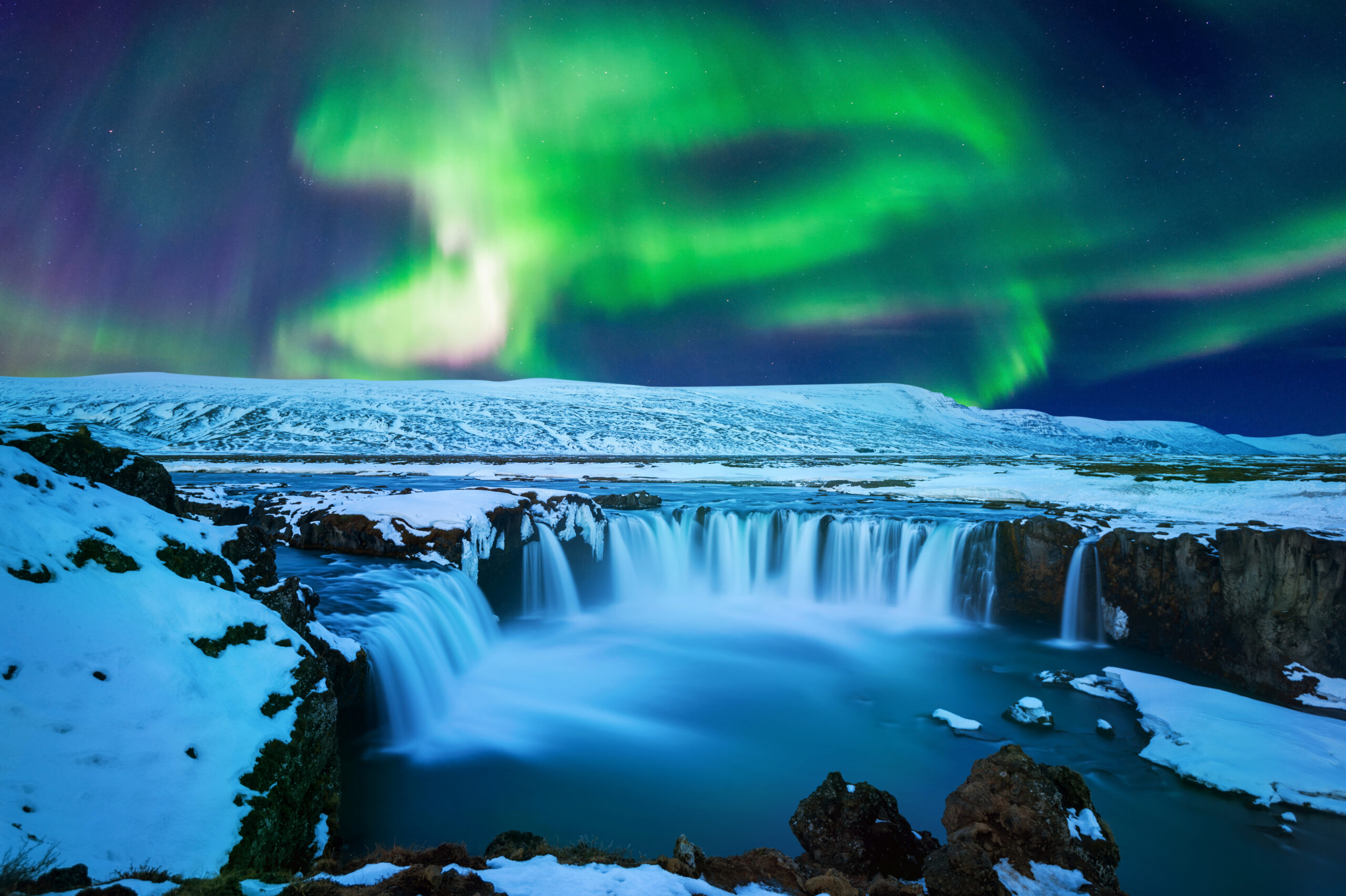Northern Lights in Iceland: When, Where and How to See Them
The Northern Lights in Iceland are one of the most breathtaking natural wonders on Earth. These glowing ribbons of green, pink, and purple light dance across the Arctic sky from late August to April, turning the night into pure magic.
In this guide, you’ll learn when and where to see the aurora borealis in Iceland, how to check the forecast, and what to expect when chasing this incredible phenomenon. Whether you have just a few days or a full week, these tips will help you plan an unforgettable experience under Iceland’s winter skies.
When to See the Northern Lights in Iceland
The Northern Lights season runs from late August to mid-April, when the nights are long and dark enough. During summer, Iceland’s midnight sun makes sightings impossible.
Best Months to see Northern Lights
The best time for aurora viewing is September to March, with peak chances between November and February.
- September–October: Mild weather, fewer tourists, and reflections in lakes and waterfalls. If you are lucky, you will be able to see auroras in Iceland from late August.
- November–February: The darkest months, offering up to 20 hours of night—perfect for hunting lights.
- March–April: Slightly warmer and clearer, with frequent aurora activity.
Best Time of Night
The aurora usually appears between 9 PM and 2 AM, though it can happen any time it’s dark. Keep an eye on the sky—sometimes it starts suddenly and lasts only a few minutes.
Where to See the Northern Lights in Iceland
You can see the Northern Lights almost anywhere in Iceland with dark sky and clear weather. Some locations, however, are especially magical.
1. Vík í Mýrdal – The South Coast Gem
Vík is one of the top spots to see the Northern Lights in Iceland. This small coastal village offers wide open views of the sky, surrounded by black sand beaches and dramatic cliffs.
From Vikurfjara Beach, you can often watch the aurora above the Reynisdrangar sea stacks. In winter, it’s common to see the lights shimmering above the ocean waves—an unforgettable contrast of fire and ice.
2. Þingvellir National Park
Located on the Golden Circle route, Þingvellir offers one of the best dark-sky locations in Iceland. The rift valley and open plains make perfect conditions for clear aurora views and stunning photographs.
3. Jökulsárlón Glacier Lagoon
On Iceland’s southeast coast, Jökulsárlón creates a mirror-like reflection of the Northern Lights on its floating icebergs. It’s a must-see for photographers and one of the most otherworldly sights in the country.
Located in Vatnajökull, the biggest glacier of Europe, this location will allow you to make amazing photographies of the northern lights.
4. Snæfellsnes Peninsula
Known as “Iceland in Miniature,” this region offers volcanoes, beaches, and glaciers—all under one aurora-filled sky. The iconic Kirkjufell Mountain is a favorite for travelers and photographers seeking the perfect aurora shot.
5. Reykjavík and Surroundings
Even from the capital, you can sometimes catch the Northern Lights. Drive just outside the city—to Grótta Lighthouse, Heiðmörk Nature Reserve, or the Reykjanes Peninsula—for darker skies and easy access.
5. North of Iceland – Arctic Views and Clear Skies
North Iceland offers some of the clearest skies and longest nights in the country — ideal for northern lights hunting.
In Akureyri, Iceland’s northern capital, you can often see the aurora just outside town, especially around Eyjafjörður fjord or Hjalteyri village.
Further east, Lake Mývatn is famous for its calm reflections and lack of light pollution. Watching the lights while soaking in the Mývatn Nature Baths is an unforgettable Arctic experience.
Along the coast, Húsavík and Ásbyrgi Canyon offer remote, quiet spots where the aurora shines bright over the sea and snowy cliffs.
If you’re seeking a peaceful, authentic encounter with the aurora borealis, the north is one of Iceland’s best-kept secrets.

Understanding the Aurora Borealis
The aurora borealis happens when charged particles from the sun collide with gases in Earth’s atmosphere. These interactions release energy as glowing colors—most often green, but sometimes pink, violet, or even red.
Why Iceland Is Perfect for the Aurora
- Close to the Arctic Circle
- Minimal light pollution outside cities
- Easy access to remote, dark locations
- Long winter nights for extended viewing
In short: Iceland’s geography and natural darkness make it one of the world’s top aurora destinations.
How to Check the Northern Lights Forecast
Watching the sky isn’t just luck—it’s planning. Here’s how to read the Iceland Northern Lights forecast before heading out.
1. The KP Index
The KP Index measures geomagnetic activity on a scale from 0 to 9.
- 0–2: Weak, visible mostly in northern areas
- 3–4: Moderate, visible across most of Iceland
- 5+: Strong—visible almost everywhere
For the best odds, aim for KP 3 or higher and clear skies.
2. Cloud Cover Forecast
Even high activity won’t help if clouds block the view. Use the Icelandic Meteorological Office (vedur.is) to check real-time cloud maps. Look for white or light green zones—they indicate clear skies.
3. Recommended Apps
- Vedur.is (official Icelandic forecast)
- Aurora Service Europe
- My Aurora Forecast App (mobile alerts & KP updates)
Tips for Seeing the Northern Lights
To maximize your chances of success:
- Get away from light pollution. Drive 10–15 minutes out of town.
- Be patient. The lights can appear after hours of waiting.
- Dress warmly. Layers, gloves, and waterproof boots are essential.
- Use a tripod for photos. Long exposures capture the movement beautifully.
- Avoid bright lights. Use a red flashlight or phone night mode.
- Join a local guide. They know the best spots to see the northern lights and know how to drive in snowy terrains.
Why Iceland is a perfect destination to see Northern Lights
The Northern Lights in Iceland are more than just a spectacle—they’re a connection between nature, history, and human wonder. With vast open landscapes, easy accessibility, and clear winter nights, Iceland gives every traveler a real chance to experience this phenomenon.
Even if the lights don’t appear, you’ll still find magic in the journey—standing under a vast Arctic sky, surrounded by glaciers and volcanoes, feeling the same awe that ancient Vikings once did.
And when the aurora finally dances above you, you’ll understand why so many call it the heartbeat of the North.
More from our blog
